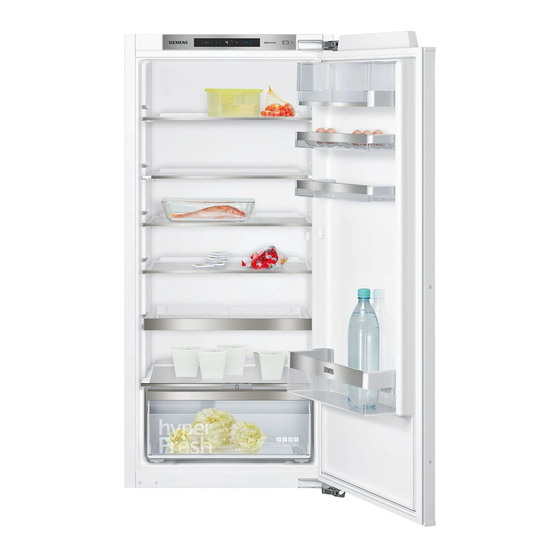
Summarization of Contents
Safety Instructions
About These Instructions
Read and follow operating and installation instructions for important information.
Risk of Explosion
Avoid flammable propellants and store high-percentage alcohol safely.
Risk of Electric Shock
Ensure proper installation and use original parts for safety.
Risk of Injury
Be aware of risks like carbonated drinks bursting.
Danger Due to Refrigerants
Handle refrigerant R600a carefully as it is flammable.
Intended Use and Safety Precautions
Child and Vulnerable Person Safety
Supervise children and vulnerable people, ensure they understand hazards.
Risk of Suffocation
Keep lock keys and packaging parts away from children.
Preventing Appliance Damage
Do not stand on the appliance or block openings to prevent damage.
Appliance Weight Considerations
Note the appliance's heavy weight during installation and transport.
Proper Appliance Usage
Use appliance only for refrigerating food in a home environment.
Environmental Protection and Installation
Packaging Disposal
Dispose of recyclable packaging materials responsibly.
Old Appliance Recycling
Ensure safe disposal of old appliances to reclaim raw materials.
Contents of Package
Check all parts upon unpacking and contact dealer if complaints arise.
Technical Specifications
Find refrigerant, cubic capacity, and specs on the rating plate.
Installation Location
Ensure adequate room size for refrigerant and ventilation.
Permitted Room Temperature
Understand how climatic class affects permitted room temperatures.
Cavity Depth Recommendation
Recommended cavity depth of 56 cm for optimal energy consumption.
Energy Saving Tips
Follow instructions for reduced power consumption during installation and use.
First-Time Appliance Use
Remove protective film and clean before initial use.
Electrical Connection
Connect appliance to a correctly installed socket matching specifications.
Getting to Know Your Appliance
Appliance Overview
Identify main parts of the appliance using diagram Fig. 1.
Control Panel Overview
Understand the function of buttons 1, 2, and 3 as shown in Fig. 2.
Refrigerator Compartment Display
Display indicates set temperature in °C.
Alarm Button Function
Button to switch off the warning signal.
Interior Fittings Guide
Instructions for adjusting, removing shelves, vario shelf, extendable shelf, and container.
Operating the Appliance
Switching on the Appliance
Press button to start cooling and set temperature.
Initial Operating Tips
Tips for initial operation, including waiting for temperature and housing heat.
Switching Off and Disconnecting
Steps to switch off, disconnect, and clean the appliance.
Setting the Temperature
How to set the refrigerator compartment temperature using +/- buttons.
Super Cooling Function
Activate Super cooling for rapid cooling of the compartment.
Alarm Functions
Door Alarm Operation
Understand and disable the door alarm.
Refrigerator Compartment
Food Storage Guidelines
Guidelines for storing food to maintain quality and prevent flavour transfer.
Refrigerator Chill Zones
Identify coldest and warmest zones for optimal food storage.
Humidity-Controlled Vegetable Container
Use container for fruit/veg with adjustable humidity.
Defrosting and Cleaning
Refrigerator Compartment Defrosting
Understand automatic defrosting and condensation drainage.
Defrosting Notes
Notes on air humidity, cold-sensitive foods, and condensation.
Cleaning Precautions
Avoid abrasive cleaners and never clean shelves in the dishwasher.
Cleaning Procedure
Step-by-step guide for cleaning the appliance.
Odours and Noise
Cleaning Equipment and Channels
Clean internal parts, condensation channel, and shelves.
Eliminating Unpleasant Odours
Steps to take if experiencing unpleasant odours.
LED Light Information
Information on the maintenance-free LED light.
Normal Operating Noises
Identify common operating noises like droning, bubbling, clicking, cracking.
Preventing Operational Noises
Tips to prevent noises by ensuring appliance level and fittings secure.
Faults and Troubleshooting
Temperature Discrepancies
Troubleshooting steps for temperature discrepancies.
Display Illumination Issues
Check power, plug, and fuses if displays are off.
Error Code 'E...' Display
Contact customer service for electronic faults indicated by 'E...'.
Warning Signals and Alarm Lights
Address open doors or covered ventilation openings.
Cooling or Display Failure
Check for showroom mode and run appliance self-test.
Customer Service and Support
Contacting Customer Service
Contact customer service for unresolved faults and provide product/production numbers.
Appliance Self-Test Procedure
Guide to running the self-test program to identify faults.
Repair and Fault Advice
How to get repair advice and contact information for service.
Warranty Information
Information on warranty period and conditions.

















Need help?
Do you have a question about the iQ500 KF21R Series and is the answer not in the manual?
Questions and answers